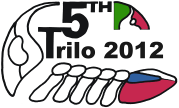Jorge Esteve
| Name: | Dr. Jorge Esteve |
| Country: | Spain |
| Institution: | University of California, Riverside |
| Address: | Jorge Esteve Department of Earth Sciences, University of California, Riverside, California 92521, USA |
| E-mail: | jorgeves (at) unizar (dot) es |
Contributions
The relationship between enrolment and caudalization in basal trilobites
Jorge Esteve, Nigel C. Hughes & Samuel ZamoraSection: Palaeobiology and palaeoecology, Presentation: Oral
Redlichiids, arthropods, trilobites, Cambrian, evolution
The ability to enroll effectively evolved several times among trilobites. Here we show that, unlike most redlichiid trilobites which could not enroll, both morphotypes of Eccaparadoxides pradoanus from the middle Cambrian of Spain enrolled so as to enclose most of the ventral surface beneath the exoskeleton, and possessed specialized articulating devices that facilitated this behaviour. The holaspid thorax of all E. pradoanus was divided into two main regions. The boundary between these marked a transition from anterior segments with short pleural spines, fulcra, and ridge-and-groove inner pleural regions to posterior segments with longer, accuminate pleural spines that lack fulcra and inner pleural regions. Devices that aid articulation, such as fulcra with short articulating pleural surfaces, petaloid articulating facet, and long articulating half rings, are concentrated in the anterior region. These features, and the large number of specimens preserved in various degrees of enrollment, suggest an enrollment procedure in which the rear part of the trunk, containing both the posterior thorax and the pygidium, rotated as a single unit without significant internal flexure. As these posterior trunk articulations were evidently not required to permit enrollment, this habit of concentrating flexure in the anterior may presage the caudalized condition seen in many encapsulating derived trilobite groups, in which a large proportion of the posterior trunk segments were allocated to the mature pygidium, and therefore unable to articulate. Reduction of the number of thoracic articulations limited the number of sites at which predators might rupture the trilobite body, driving the repeated independent trend toward caudalization.
Enrolment and life habit in agnostids from Cambrian series 3 of the Iberian Chains (northeastern Spain)
Jorge Esteve & Samuel ZamoraSection: Palaeobiology and palaeoecology, Presentation: Poster
Cambrian, Spain, trilobites
Here we described a new find that shed new light about enrollment and life habit in agnostids..

NEWS

NEW PHOTOS: Participant's photos
Participant's photos
NEW PHOTOS: Sessions and dinner
Photos from sessions and the conference dinner
NEW PHOTOS: Mid-conference trip
Photos from Mid-conference field trip
NEW PHOTOS: Pre-conference trip and Icebreaker party
Photos from Pre-conference field trip and the Icebreaker party
CIRCULARS & DOCUMENTS
WHEN & WHERE
26th – 29th June: Field trip
1st – 4th July: Conference
5th – 9th July: Field trips
Lower Palaeozoic of the Barrandian area, Czech Rep.
1st – 4th July: Conference
Geoscience Building of the Faculty of Science of Charles University, Albertov 6, Praha 2, Prague, Czech Republic (maps)
5th – 9th July: Field trips
Sardinian Lower Palaeozoic, Italy and Late Palaeozoic in Moravia, Czech Republic












